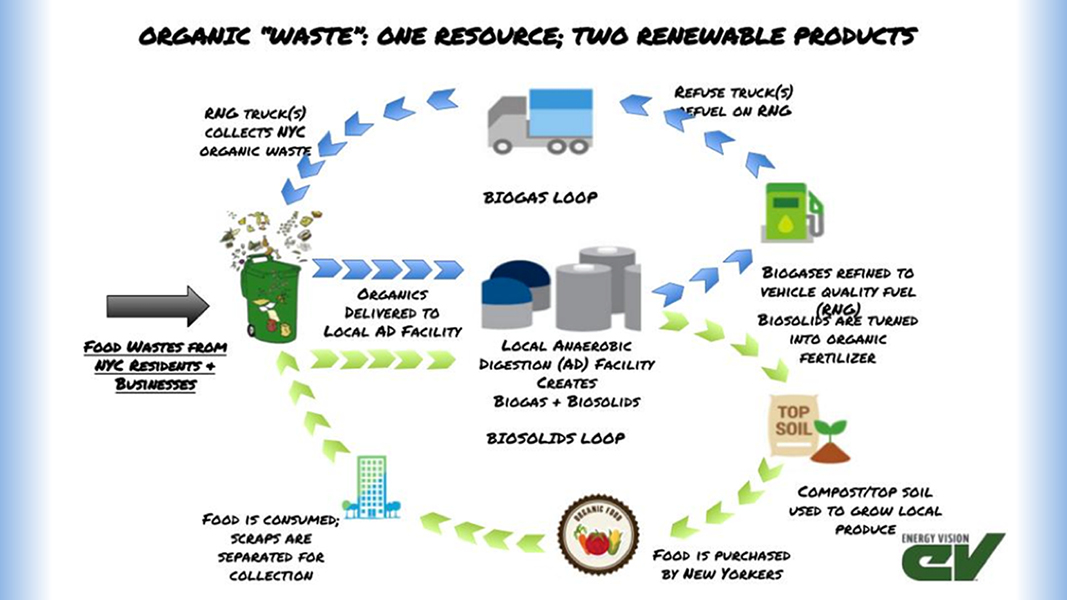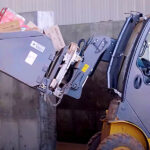Top: New York City’s closed loop system illustrates anaerobic digestion’s potential for all of New York State. Graphic courtesy Energy Vision
A new report from Energy Vision — a New York-based nonprofit that focuses on the policy, technology, and economic elements of anaerobic digestion and decarbonization — makes a strong case for building anaerobic digestion infrastructure in New York State (NYS) to help achieve its climate goals, improve public health, and foster economic development. Written by Michael Lerner and Matthew Tomich, Putting New York’s Organic Waste To Work starts with some compelling statistics:
- Methane comprises a full 39% of New York’s greenhouse gas (GHG) emissions and organic wastes account for 34% of the state’s methane emissions. Organic wastes generate nearly triple the methane emitted by the oil and gas industry (including pipelines) in NYS.
- Building all achievable new anaerobic digesters (ADs) — roughly 300 — could reduce New York’s methane emissions by 15%, an essential strategy for achieving the State’s climate goals.
“Diverting organic wastes from landfills to ~20 new ADs could reduce NYS’ net methane emissions from solid waste management and exported waste by 90%,” write Lerner and Tomich. “This would lower total NYS methane emissions by 11.2%. In the agricultural sector, building ~260 new ADs could cut methane from dairy manure by 56.5%, trimming another 3% from total NYS methane emissions. Building ~20 ADs at additional major wastewater plants could reduce total NYS methane by another approximately 0.8%.” Combined, that is a total of 15% reduction in methane emissions.
The report calculates that these 300 new AD projects would be worth about $3.4 billion in capital deployed, and could equate to about 8,000 new jobs in the state. Energy Vision advocates for using renewable natural gas (RNG) made from conditioned digester biogas in heavy-duty vehicles, replacing diesel fuel. “NYS could produce enough RNG to displace 320 million gallons of diesel per year,” notes the report. “This amount of RNG could power some 32,000 refuse trucks — enough for more than 15x the number of garbage trucks in New York City or about one sixth of the nationwide refuse truck fleet.”
Putting New York’s Organic Waste To Work recommends two policy changes to accelerate the expansion of AD infrastructure and RNG use in NYS: adopting lifecycle carbon accounting and passing a Clean Fuel Standard (CFS), similar to what is in place in California, Oregon and Washington. Lifecycle carbon accounting measures all greenhouse gases associated with a fuel or energy source, from production and transportation through end-use, rather than measuring just emissions from vehicle tailpipes and smokestacks in the State. A CFS is a program in which producers selling low carbon fuels into that state’s transportation sector earn valuable credits, while producers selling high carbon fuels must buy credits from the clean fuel producers. “Virtually no government funds are spent on implementing these standards; instead, the high carbon fuel producers are actually paying for the expanded use of clean fuels,” explain Lerner and Tomich.
There is brief mention about the benefits of utilizing the digestate from the ADs, both directly and by composting the solids. Further analysis of these benefits can strengthen the case for building out New York’s anaerobic digestion infrastructure.













